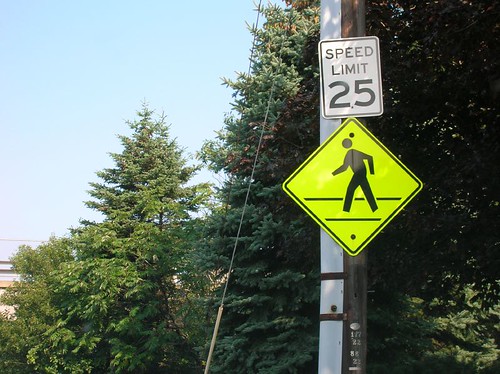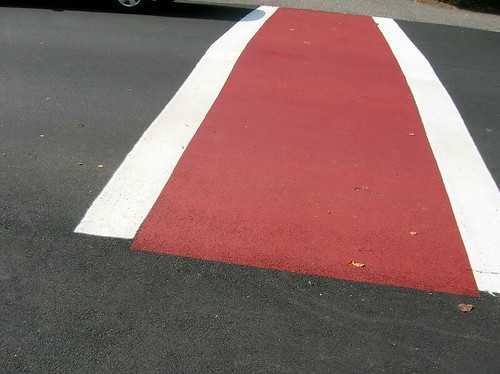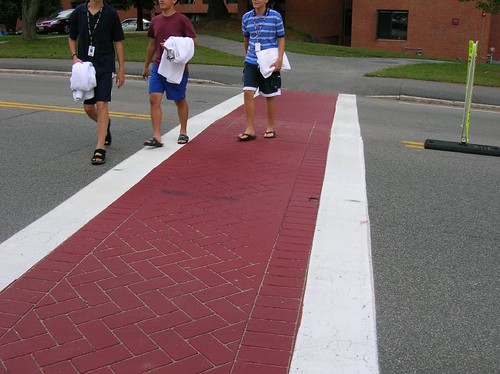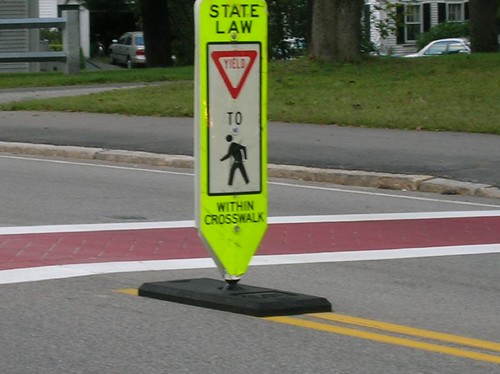Finishing up a visit to the East Coast, I’m reminded again about my strong feelings about the way we treat crosswalks in Portland.
We’re told by the engineers that adding crosswalks gives pedestrians a false sense of security. As an engineering principle, that may have some validity (although new studies question it).
But it’s simply the wrong frame. This is not about engineering. It’s about instilling a culture among drivers that you stop as soon as a pedestrian puts a foot in the crosswalk.
It’s not hard. You just have to keep reinforcing the point. This series of photos from New Hampshire makes it clear:
- Tell drivers a crosswalk is coming
- Make the crosswalks distinctive, using either different materials or clear color differences. White stripes are not enough
- Popup signs are a great additional element. I’m SURE we could talk the business districts in any number of Portland neighborhoods to fund these.
And it works! Drivers really do behave differently around these crosswalks.




28 responses to “Crosswalks: It’s Culture, not Engineering”
This is the first entry where I’ve seen you take a very individual responsiblity approach to something.
Businesses pay for crosswalk signs is a great idea. I’m so used to hearing that the local city, state, or federal Government should pay for everything I almost fell out of my chair!
Getting drivers to pay attention is also a great idea. If only the licensing process (maybe it should be privatized with strick standards enforced via the police?) was strick and actually required people to not just know the rules, but also about the vehicle(s) and how they handle, drive, what should be done in an emergency, and more.
I’ve always said, per more than one rant on my blog(s), that the problem is never cars or speed but simply driver training, awareness, and knowledge.
Tigard has tried some interesting concepts – using embedded crosswalk lights in the pavement, improved signage and flashing lights.
Ultimately, it comes down to enforcement. In Newberg years ago, the police cracked down on those who didn’t stop at crosswalks; nearly everyone I knew had a crosswalk ticket one time or another in Newberg (I didn’t!) Since police have gone on to other things, people feel they can get away with it – just like people run red traffic lights, do 10 miles over the speed limit, or don’t bother to use their turn signal.
The problem is that in Oregon every crossing at every corner, marked or not, is a “crosswalk,” and motorists are supposed to stop for peds.
I think one way to “train” motorists is for pedestrians to be more assertive in crossing, using hand signals, body language and eye contact to make clear that they have the right of way. One can do this without taking undue risk, especially where design and speeds are reduced.
I was once in Rome and waited for what seemed like hours for a break in traffic to cross a busy arterial…later when folks were getting off work, I noted Roman peds just walking across the street like they owned it…and cars slowed, stopped or at least avoided these assertive peds who did not break stride or pause in their lively conversation. We are just to timid when it comes to crossing streets.
I’d like to back up what Lenny said. In italy especially, but europe in general as well, pedestrians have the attitude that they own the street. You just walk and make sure the driver sees you.
It works in portland too.
I will attest to this phenomenon in Rome. It’s pretty freaky if you aren’t used to it… but don’t try it in London, drivers will run you over. However, they have ped lights on every corner, and they honor those to the T – no rights on red!
I would really like to see pedestrian islands installed on more streets – wide ones, mind you – to allow slower people, elderly & children a better chance to cross a wide, busy street – and a nice concrete curb tends to make drivers a little more aware, too.
I’m not saying to go as far as installing rails like London has, although that is the ultimate in sidewalk safety.
The key is reducing speeds and shortening crossing distances.
Up on NE Fremont in the Beaumont District they have posted 20 MPH signs, which seem to be noticed by some drivers, but yesterday as I negotiated that street, a few just blew by (one had Wash. plates).
Curb extensions are the ticket….they get you out where you can see and be seen, they shorten the distance to the other side, and they narrow the street. Relatively little parking is lost, and if combined with bus stops actually increase the amount of parking. Finally, they create a bit more sidewalk space…(check out the corner of SE 34th & Hawthorne to see this effect.)
The signs in the third picture do more than just tell people to yield. They put a physical barrier in the middle of the street. They aren’t as good as a median but they do have a traffic calming effect, unlike signs that tell people to slow down. And they are a lot cheaper. It would be good to put a bunch of them at unmarked crossings so that people would get the message that pedestrians still have the right of way.
Lenny Anderson: Curb extensions are the ticket….they get you out where you can see and be seen
JK: And where you can be hit more easily by the same type of driver that hits parked cars and telephone poles. They also cause congestion by preventing right turning drivers from pulling over as they turn.
Lenny Anderson: if combined with bus stops actually increase the amount of parking.
JK: Where buses are forced to stop in the middle of the travel land, increasing congestion and costing trucking companies more money.
Thanks
JK
I believe that safety trumps congestion…indeed the latter helps insure the former, especially in commercial districts and on transit streets. NW 23rd is a good example…south of Northrup it is congested and safe, to the north it is fast and deadly.
I tend to agree with Lenny. Pedestrians have the right of way at ALL crosswalks whether they’re marked or not. That’s what drivers need to learn. Sure, you can make special crossings in especially dangerous areas, but it also sends a message to drivers that they only have to yield to pedestrians where there’s a fancy crosswalk.
I too think pedestrians should assert themselves at ALL street crossings (without jumping in front of a car that’s 10 feet away). Police should continue sting operations to enforce this law and educate drivers. And, does driver education teach this law and do they test for it on the driving test?
Lenny,
I personally own significant property on NW 23rd north of Northrup (Quimby) and all I can tell you and other that you are again talking out of your hat.
Safety and congestion is almost equal up and down 23rd Avenue. If anything it worse from Lovejoy south with how PED’s cross the street jumping out from curbs, between cars and don’t look or care.
Only when you get north Vaughn Street is there any differences.
The curb extensions (funded and built with bike path monies) make it safer and a shorter distance for the bikes and PED’s to navigate getting back and fourth across the street and that has worked out.
The real problem is the people and I am not talking about the people holding on to a steering wheel in a motorized vehicle.
Peds never killed anyone that I know of.
J-walking is actually safer than legal crossing…mid block you need only worry about two directions, not 16 or so. Also, signals are a peds worse friend…we tend to believe to readily that vehicles will stop at red lights.
NW 23rd approaches that mix of modes at slow speeds that makes a place safe and welcoming to all. We need more of that in other commerical areas.
They also cause congestion by preventing right turning drivers from pulling over as they turn.
I could be wrong, but it seems that in most places curb extensions take up room that would be used for parking. I do not believe that they usually take out a right turn refuge to put one in.
Also, they were testing the sign in the last picture while I was living in Madison, WI.
Speaking of safe driving speeds, why is it that almost every business district in Portland, except for Multnomah Village, Downtown, and now 23rd, has a 30 mph speed limit?
According to state law, it should be 20. Portland doesn’t give a shit?
Curb extensions that do not have a bus stop do not take parking, as parking is not allowed within 20 or so feet of corners. Curb extensions that do have bus stops add parking, as bus pull outs typically take twice the curb space of a curb extension.
Right turn lanes are particularly bad for pedestrians…note the number of incidents on W. Burnside with a right turn lane every other block for traffic coming off the bridge. Peds crossing with the green are clipped from behind.
Posted speeds in commercial districts…it seems the City only limits those when there is blood on the pavement or strong demand from the business community. Finally NE Fremont in the Beaumont District got 20 MPH signs…for what they are worth. N. Mississippi Avenue is still posted 30 MPH with all the activity there…its even double striped for a stretch. Thankfully there is lots of double parking at ReBuilding Center, so things are calmed “naturally,” so to speak.
Removing lane striping is a real cheap way to calm traffic…drivers have to “negotiate” with oncoming traffic.
SE Hawthorne between 34th and 38th would do well to have some of these crosswalk markings. It is a gauntlet made worse by off kilter intersections which can mean that peds cross at an intersection end up in middle of block on other side. ANd for motorists on Hawthorne, the lack of markings makes it harder to see where “crosswalks” are on the off kilter streets.
Adron’s point about enforcement is also key. Far more dangerous to not yield to peds (thank you Mayor Potter for being “bait”) than for example to speed on the I-5 in Oregon where in Washington the same type of roadway would be controlled by a 70mph limit. In general, I would support lowering speeds in town and raising them on the Interstates.
Lenny Anderson in support of curb extensions said “I believe that safety trumps congestion”
If that is the case then a whole lot more signs are needed like the one at NE 17th and Weidler that restricts large trucks from making a turn due to the curb extension. If safety trumps congestion, it should be illegal for all large trucks to make turns at intersections where curb extensions exist. It is very unsafe for tractor trailer rigs to swing wide to clear the curb extension or run up over sidewalk and in danger pedestrians. I have personally observed a car run over by a truck trailer because the truck had to make a right turn from the left turn lane due to a curb extension and did not signal for the right turn until the car was beside the truck where the driver could not see the truck’s right turn signal.
The fact is curb extensions are not safe. They place pedestrians waiting at the curb closer to moving traffic in addition to increasing congestion which then increases fuel consumption for motorists.
Furthermore if safety trumps congestion, bicycles should be banned from all freeways and not allowed on a large number of Portland streets, including many of them downtown and those with curb extensions.
Just catching up on this thread after traveling all day. A couple of thoughts:
The problem is that in Oregon every crossing at every corner, marked or not, is a “crosswalk,” and motorists are supposed to stop for peds.
And we seem to go out of our way to make it easy for them to ignore this. My hypothesis is that aggressive visual indicators would be a big help with this.
Speaking of safe driving speeds, why is it that almost every business district in Portland, except for Multnomah Village, Downtown, and now 23rd, has a 30 mph speed limit?
This is a great point, but there is some nuance involved. A body called the “Speed Control Board” (a state function) has some authority over this. I’ll see if I can get someone who understands how this works to author a post.
…all I can tell you and other that you are again talking out of your hat.
Paul, Portland Transport is, as the banner says, a conversation. Denegrating the perspectives of others is not a good technique for productive conversation. Your perspective is welcome, but please present it as such, not as the only correct point of view.
I live half a block off 23rd (north of Northrup) and agree with the prior perspective that pedestrian safety is sharply different north and south of Lovejoy (but still better than many other business districts).
I’m not sure there is a real problem to be solved here. Does Portland rank high in pedestrian deaths? I hear alot more noise about problems with drivers and cyclists, but I attribute that to a very vocal cycling group here in PDX. Do we have intersections that pedestrians are afraid to cross?
Ultimately, it is the peds (I’m a full-time pedestrian) responsibility to check for a oncoming vehicle, as like it or not as a pedestrian you have quite alot more to lose than even the most negligent driver. Sure, neat colored intersection might create the impression of being more pedestrian friendly. More signage could be better, although I suspect that extra signing comes with rapidly diminishing returns.
The emperical result for me was this observation:
Put your foot into the crosswalk:
Portland: no reaction from drivers
New Hampshire: 9 out of 10 drivers stop
re trucks and curb extensions…on Russell Street in Lower Albina, PDOT working with area truckers and others came up with a truck friendly curb extension design. Curb extensions help trucks by keeping parked cars off of corners…which is the most difficult situation for large trucks. A truck can negotiate a curb extension by slowly going over the curb in necessary…hard to go over a parked car!
If a ped’s object is to cross a street, why wouldn’t they want to get as close to the traffic as possible, especially from the protection of a raised curb?
Do we have intersections that pedestrians are afraid to cross?
The area around SE 22nd through SE 24th and Hawthorne, where I cross, has no marked crosswalks, and cars are allowed to park IN the crosswalks. Cars coming downhill toward the city at rush hour are not especially inclined to stop for pedestrians. I watch people running across the street every morning. In the SW, crossing Bweaverton-Hillsdale is so dangerous that people won’t let their kids cross it to walk to school.
A truck can negotiate a curb extension by slowly going over the curb…why wouldn’t (a pedestrian) want to get as close to the traffic as possible, especially from the protection of a raised curb?
Because you are standing IN traffic, offered no protection from a “raised curb” that is often deliberately –and sometimes accidentally– ignored, as you suggest above.
I think Chris has hit on something, though. As fast as cars may race though the streets in Paris, in Germany, in Europe overall…cars stop for you when you step off the curb. There’s a different attitude, which I suspect derives in part from better enforcement, and, in part, from different cultural values.
Well, I think I might have an interesting perspective on this subject since I just moved to Beaverton a few weeks ago from Boston, MA.
Simply having crosswalks will not make it safer for peds. My hometown of Boston (and its surrounding suburbs) are littered with crosswalks, yet peds must still risk their lives to get across the street. Few drivers will stop for a ped, even in a crosswalk. On some faster moving high volume streets its not uncommon to have to wait several minutes, either for a break in traffic, or for a decent person who usually has a New Hampshire license plate.
Which leads me to my next point. Cross the border into New Hampshire and its a whole different world. If you even glance in the direction of a crosswalk cars slam on the breaks! I’m not real sure why that is. New Hampshire has little law enforcement, and its residents generally have no respect for law (or taxes). Seriously, its the “Live Free or Die” state!
My best theory is that it is a cultural thing, as suggested by the blogger. Right now, I think that things in the area are heavily slanted against the pedestrian. Many areas lack sidewalks, or only have them on one side of the street. The walk signals at crosswalks are timed in favor of vehicles and require peds to be very quick footed. Most importantly though, drivers need to be constantly and consistantly reprimanded for ignoring peds in the crosswalk. Ticketing is not optional. There must also be a massive drivers ed plan, begining with the drivers ed manual but covering everyone.
So basically, you need to change peoples ideas and crosswalks are only a part of it, though a very significant part.
I don’t think the crosswalks are enough, I think you need the additional signage, especially those little pop-up signs in the middle of the street.
Are those present in Boston?
Yeah, we had them in some places. I can testify that you would be absolutely wasting you time with them.
For a while I lived on a very busy street in a suburb. There was a crosswalk with such a popup sign and the drivers completely ignored it. I probably averaged a close call per week.
Again, I really think its a cultural issue, and since Bostonians are jackasses (yes, me too) the cops need to enforce it, which they have failed at. Theres also pretty much no education for drivers on the subject. If we want signage that may help, prehaps large hanging signs possibly with blinking yellow lights would help. And scatter signs all over town talking up the fine. But of course, that would be expensive.
“safety trumps congestion”
“A truck can negotiate a curb extension by slowly going over the curb if necessary”
Congestion is OK in the name of safety but it is OK for large trucks to run over the sidewalks (and maybe anything that is on the sidewalk too). This is yet demonstrates another double standard related to mode. Safety should trump trucks from driving on the sidewalks.
Anyway, curb extensions (and bike lanes) are better for truck movement than parked cars.
But all this ped safety stuff boils down to speed, speed, and speed…lower design speed, lower posted speed limit, more enforcement of same and…yes, more congestion which Portland by and large lacks.
Slowing traffic on 4 lane arterials…B/H Hiway and Hawthorne…will never happen; I guess signals are the only options there.